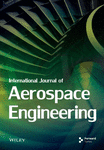VB-Based Gaussian Sum Cubature Kalman Filter for Adaptive Estimation of Unknown Delay and Loss Probability
Abstract
The traditional Kalman filter assumes that all measurements can be obtained in real time, which is invalid in practical engineering. Therefore, a variational Bayesian- (VB-) based Gaussian sum cubature Kalman filter is proposed to solve the nonlinear tracking problem of multistep random measurement delay and loss (MRMDL) with unknown probability. First, the measurement model with MRMDL is modified by Bernoulli random variables. Then, the expression of the likelihood function is reformulated as a mixture of multiple Gaussian distributions, and the cubature rule is used to improve the estimation accuracy under the framework of Gaussian sum filter in the process of time update. Finally, by constructing a hierarchical Gaussian model, the unknown and time-varying measurement delay and loss probability are estimated in real time with the state jointly using the VB method in the measurement update stage. The algorithm does not need to calculate the equivalent noise covariance matrix so as to avoid the possible division by zero operation, which improves the stability of the algorithm. Simulation results for a target tracking problem show that the proposed algorithm has a better performance in the presence of MRMDL and can estimate the unknown measurement delay and loss probability accurately.
1. Introduction
Kalman filter (KF) has been widely used in target tracking and integrated navigation system. As a real-time recursive state estimator, KF provides the analytical solution for minimum mean square error estimation of linear systems under Gaussian noise assumption [1, 2]. KF assumes that all measurements are obtained at the current time. However, when the signal transmission network is blocked or affected by the complex environment, the measurement data may be randomly delayed and lost [3–5], affecting the estimation accuracy of KF.
To deal with this situation, many improved KFs for measurement delay and loss are proposed. In [6], the extended KF (EKF) and unscented KF (UKF) have been generalized to one-step randomly delayed system by rewriting the measurement equation into a Gaussian mixture of the updated measurement and one-step delayed measurement. In [7], the augmented state KF (AS-KF) and augmented state probabilistic data association filter (AS-PDA) are developed to scenarios devoid of clutter or involving clutter with multistep random measurement delay, in which multistep random delay is processed by state augmentation. In [8], modified adaptive EKF is proposed by reorganizing the state update equation and combining the adaptive estimation algorithm, which avoids the augmentation of state variable or measurement equation. In [9, 10], the Gaussian approximate filters and smoothers are proposed for systems with one-step randomly delayed measurements. In [11], a modified likelihood cubature Kalman filter (MLCKF) is proposed to modify the likelihood function by marginalizing the delay variables, and the modified likelihood function is in the form of Gaussian mixture. When the measurement loss is known, the problem can be solved by using the intermittent KF (IKF) [12, 13]. In IKF, measurement loss is treated as a case where the measurement noise variance is infinite. The upper and lower bounds of the estimated error covariance are given in [12], and the stability is analyzed in [13]. In [14], particle filter is applied to the system with one-step random delay and measurement loss by modifying the expression of particle weights. Then, particle filter is used for multistep delay system [15]. In [16], an optimal linear filter is derived based on the known probability under the linear minimum variance criterion. However, in the above methods, the delay and loss probability is known and constant. In practice, the probability of measurement delay and loss is often unknown and time varying. Therefore, the estimation accuracy of the above algorithms suffers severely when inaccurate prior probability is used.
In order to deal with the problem of unknown probability, some methods have been proposed to identify the probability of delay and loss. In [17, 18], the expectation maximization (EM) approach is used to obtain the estimation of delay probability. However, because they are based on the smoothing framework, they cannot identify the time-varying probability accurately. In [19], a risk-sensitive KF (RSKF) is proposed by minimizing the expectation of the accumulated exponential quadratic error for system with one-step randomly delayed measurement with unknown probability and uncertain model. In recent years, the use of variational Bayesian (VB) method to identify unknown parameters has been widely studied [20–23], such as the identification of Student’s t noise parameters [24–26]. In [27], an improved KF with one-step randomly delayed measurement is proposed. And the improved UKF (IUKF) version is presented in [28]. In a similar way, a VB-based adaptive KF with lost measurement (VBAKFLM) is proposed to achieve the estimation of a linear system with unknown and time-varying probability of measurement loss [29]. These filters use a Bernoulli variable to indicate whether the measurement is delayed or lost, and the likelihood function is transformed into a hierarchical Gaussian state model. Then, the VB method is used to estimate the probability. However, these methods cannot simultaneously estimate the state of nonlinear system with unknown and time-varying multistep delay and loss probability of measurements. In addition, there is a risk of division zero when obtaining the equivalent augmented measurement noise covariance matrix, which may cause the filter to crash.
In this article, we proposed a novel VB-based Gaussian sum cubature Kalman filter (CKF) for nonlinear system to estimate the state and identify the unknown delay and loss probability. By introducing two Bernoulli random variables, the measurement model with MRMDL is modified and the expression of the likelihood function is reformulated as a Gaussian mixture distribution. Therefore, the state estimation problem with MRMDL can be solved in the framework of Gaussian sum filter (GSF) while the cubature rule is used to improve the estimation accuracy. By constructing a hierarchical Gaussian model, the nonconjugated Gaussian mixture model is modified to conjugate exponential multiplication form by the introduced Bernoulli random variables. Then, the unknown and time-varying measurement delay and loss probability are estimated in real time with the state jointly using the VB method. Different from other VB-based filters, the proposed algorithm uses the estimated probability to update the weights without augmenting the measurement vector, which avoids the division by zero operation that may be involved in obtaining the equivalent noise covariance matrix, which improves the stability of the algorithm.
The remainder of this paper is listed as follows. In Section 2, the problem formulation is given. In Section 3, a hierarchical Gaussian state-space model for nonlinear system with MRMDL is constructed, and the VB method for joint posterior probability distribution function (PDF) is provided. In Section 4, simulation results and comparisons are shown. In Section 5, conclusions are given.
2. Problem Formulation
3. VB-Based Gaussian Sum Cubature Kalman Filter
3.1. Modification of the Likelihood Function
3.2. The Variational Bayesian Method
By updating one element of Θk while keeping the others’ estimated value constant, the VB solution of (16) can be obtained iteratively.
where can be calculated as (11).
The flow chart and one time step of the proposed algorithm are summarized in Figure 1 and Algorithm 1, respectively.
-
Algorithm 1: The proposed VB-based Gaussian sum cubature Kalman filter algorithm.
-
Input: ,
-
1Time update:
-
3 , ,;
-
4 Variational measurement update:
-
5Initialization , , , , , , , , , ;
-
6 for d = 0to D − 1do
-
7 Update given E(d)[ρk] and E(d)[λk] using ((33));
-
8 Update E(d + 1)[ρk] using ((38));
-
9 Update and using ((40));
-
10 Compuate E(d + 1)[log(γk)] and E(d + 1)[log(1 − γk)] as ((36));
-
11 Update E(d + 1)[λk] using ((44));
-
12 Update using ((46));
-
13 Compuate as ((43));
-
14 end
-
15 , , , , ;
-
Output:,The estimated lost probability ,The estimated latency probability
Remark 1. The common way of dealing with (23) is augmenting measurement vector, and the modified matrix is given to the diagonally augmented measurement noise covariance matrix [27, 29, 32, 33]. However, in some cases, the probability of delay or loss of a step, or , may be close to zero. It will cause to be infinite and lead to filter collapse. In this paper, this problem is avoided by using probability to update the weight of each Gaussian component. Therefore, the stability of the proposed algorithm is improved.
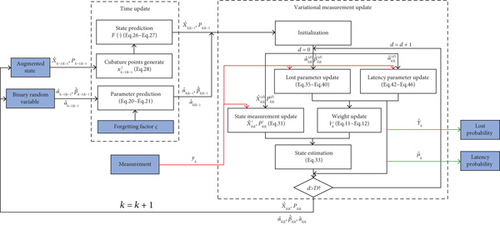
4. Simulations
The number of Monte Carlo runs is set as M = 500.
The proposed filter is compared with the MLCKF [11], the matched CKF (MCKF), the SWVAKF [23], the IUKF with a nominal lost probability (IUKF-NL) [28], and the VBAKFLM [29]. The nominal latency probability of MLCKF is set as μk = [0.5, 0.25, 0.125, 0.125]T. The window length is set as L = 5 in SWVAKF. In the IUKF-NL and VBAKFLM, the initial shape parameters are selected as . The nominal loss probability of measurement is set as 0.5. In the proposed VBGSFDLM, , , and , which is the same as the weight of MLCKF. And the number of iterations is set as D = 10, forgetting factor ς = 0.97 for SWVAKF, IUKF-NL, VBAKFLM, and VBGSFDLM. In MCKF, the delay and loss of measurement are precisely known. Therefore, the estimated result of MCKF can be regarded as the optimal result.
Figures 2 and 3 show the RMSEp and RMSEv of the VBAKFLM, IUKF-NL, SWVAKF, MLCKF, MCKF, and VBGSFDLM. And the average RMSEs (ARMSEs) are given in Table 1. It can be seen that the ARMSEs of position of the proposed VBGSFDLM is reduced by 96.45%, 96.18%, 79.67%, and 19.27%, respectively, compared with VBAKFLM, IUKF-NL, SWVAKF, and MLCKF while the ARMSEs of velocity is reduced by 96.52%, 95.88%, 74.64%, and 17.94%. Due to the fact that the IUKF-NL and VBAKFLM can only estimate the probability of one-step delay and measurement loss, respectively. The state estimation accuracy of above two filters will be affected when measurement loss and multistep randomly delay exist at the same time. Although the SWVAKF uses a sliding window to reduce the influence of multistep random delay, the estimation accuracy is still affected by time-varying delay probability because it is designed to identify time-varying Gaussian noise. While MLCKF updates the weight of each state estimation component by combining likelihood probability and multistep delay probability, it achieves some degree of robustness against inaccurate prior delay and loss probability under the framework of GSF. However, MLCKF does not have the ability to identify the time-varying measurement delay and loss probability. In the proposed VBGSFDLM, the augmented state includes the state with multistep random delay and a Gaussian component with the predicted state is added to the GSF to deal with the case of measurement loss. In addition, the augmented state and parameters are estimated jointly by VB method to obtain accurate identification of the unknown measurement delay and lost probability which improves the estimation accuracy of the state. Therefore, the estimation accuracy is the closest to MCKF. Furthermore, the true and estimated delay and loss probability are shown in Figures 4 and 5, which illustrate that the proposed VBGSFDLM can accurately estimate the multistep random delay and loss probability.
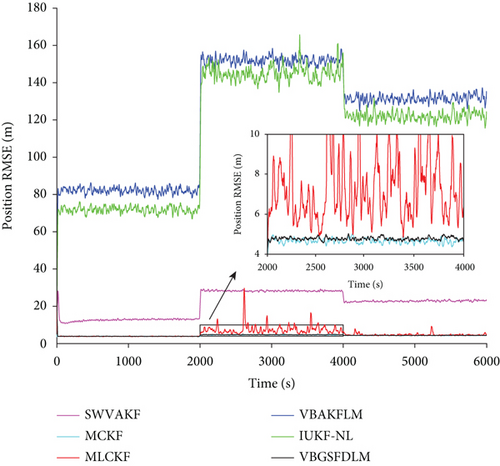
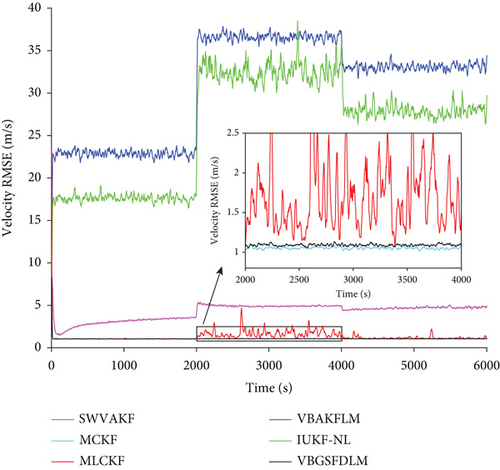
| Filter | ARMSEpos (m) | ARMSEvel (m/s) |
|---|---|---|
| VBAKFLM | 122.5286 | 30.9837 |
| IUKF-NL | 113.7579 | 26.1438 |
| SWVAKF | 21.3963 | 4.2468 |
| MLCKF | 5.3894 | 1.3123 |
| VBGSFDLM | 4.3503 | 1.0769 |
| MCKF | 4.2964 | 1.0448 |
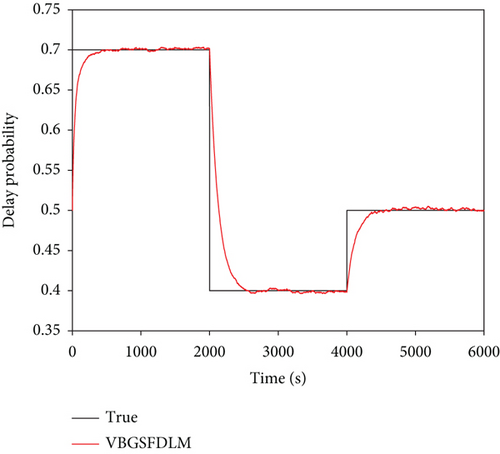
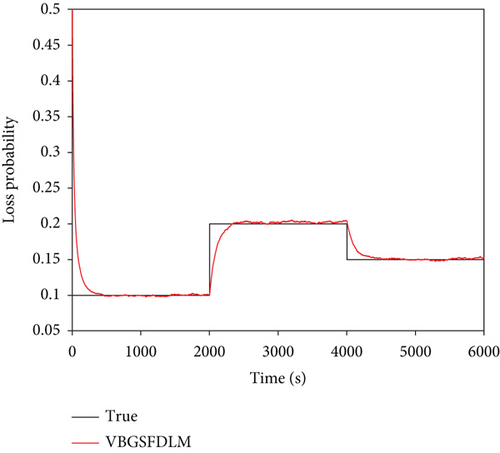
Besides, the computational complexity of VBGSFDLM is compared with VBAKFLM, IUKF-NL, SWVAKF, MLCKF, and VBGSFDLM. The number of multiplications in each algorithm is considered as the evaluation criterion. The results are shown in Table 2. And the single step running time of each filters is shown in Table 3, where Nx = (I + 1)n and Nz = (I + 1)m are the dimension of the augmented state and measurement vector, respectively. Mn = 2Nx is the number of sampling points. Mx and Mz represent the number of multiplications in nonlinear transformations F(·) and h(·) in augmented system. It can be seen that the significant improvement of estimation accuracy is at the cost of computation.
| Filter | Computational complexity |
|---|---|
| VBAKFLM | o(2n3 + n2 + D(n3 + 4n2m + 3nm2 + 3nm + 2m3 + 2m2)) |
| IUKF-NL |
|
| SWVAKF |
|
| MLCKF |
|
| VBGSFDLM |
|
| Filter | Single step running time (ms) |
|---|---|
| VBAKFLM | 3.32e-1 |
| IUKF-NL | 1.37 |
| SWVAKF | 1.53e-1 |
| MLCKF | 3.76e-1 |
| VBGSFDLM | 3.81 |
Further, we discuss the effect of the number of iterations on VBGSFDLM. Figure 6 shows the ARMSEs of position and velocity when D = 1, 2, ⋯, 20. It can be seen from Figure 6 that the VBGSFDLM has well estimation accuracy when d ≥ 4 and converges when d ≥ 8.
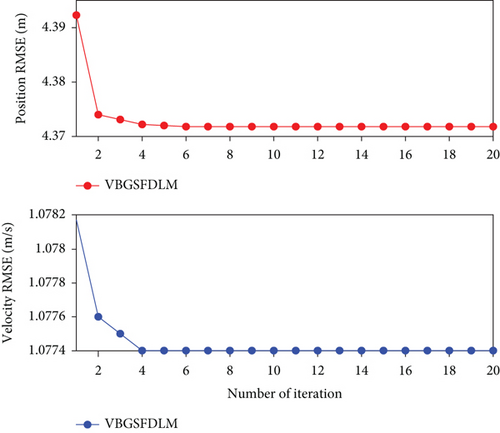
Next, we study the forgetting factor effect of the time-varying MRMDL on the performance of VBGSFDLM. Figures 7 and 8 show the true and estimated delay and loss probability. And Figure 9 shows the RMSEs of position and velocity of VBGSFDLM when ς = 0.95, 0.96, 0.97, 0.98, 0.99, and 1. It can be seen from Figures 7 and 8 that VBGSFDLM with ς = 0.95, 0.96, 0.97, 0.98, and 0.99 has essentially consistent estimation performance in probability estimation. However, VBGSFDLM with ς = 1.0 converges slowly because ς = 1.0 corresponds to the case of constant probability of MRMDL so that the estimation performance degrades when the actual probability is slowly varying. Besides, Figure 9 shows that the RMSEs of position and velocity are almost the same in different ς.

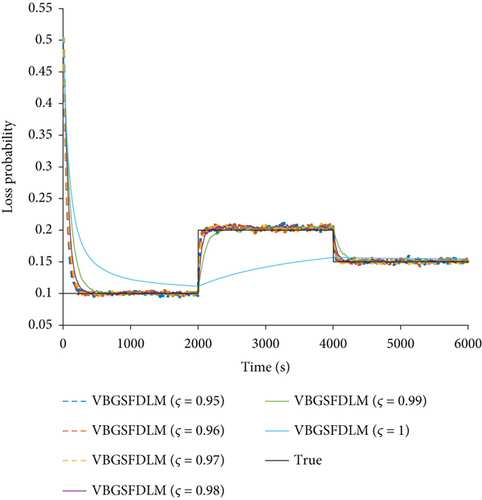
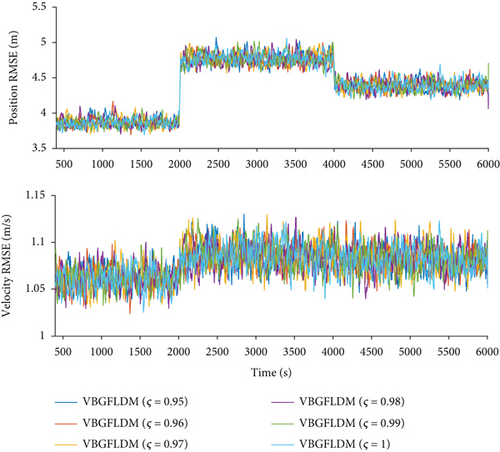
Finally, in order to investigate the influence of target maneuvering on the tracking performance of the VBGSFDLM, different values of process noise Qk = qrQ are taken in the simulation. In Figure 10, the RMSEs of position and velocity are shown with qr = 0.001, 0.01, 0.1, 1, 2, and 5. Obviously, it can be seen in Figure 10 that the tracking RMSE increases when the process noise increases. This shows that the proposed algorithm needs a precise state equation to achieve accurate estimation of unknown delay and loss probabilities. And process noise will significantly affect the estimation results of the algorithm.
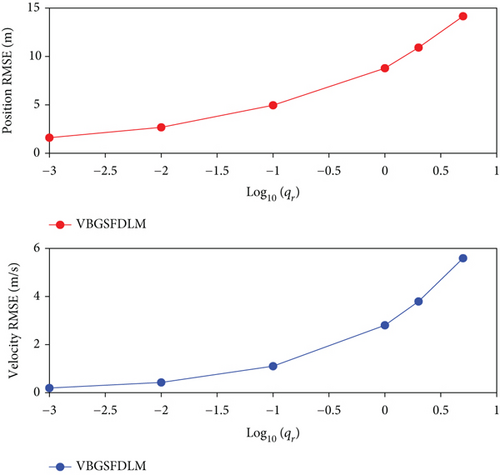
5. Conclusion
In this paper, we proposed a VB-based Gaussian sum filter to obtain the estimation of state for nonlinear systems with MRMDL with unknown probability. By introducing two random variables, the Gaussian mixture distribution is rewritten into an exponential multiplication form and VB method is used to estimate the state and the unknown measurement delay and lost probability jointly. Simulations show that the proposed VBGSFDLM has a better performance in state estimation and probability identification in the presence of unknown and time-varying delay and loss probability.
Conflicts of Interest
The authors declare that there is no conflict of interest regarding the publication of this paper.
Open Research
Data Availability
The data that support the findings of this study are available from the corresponding author.



